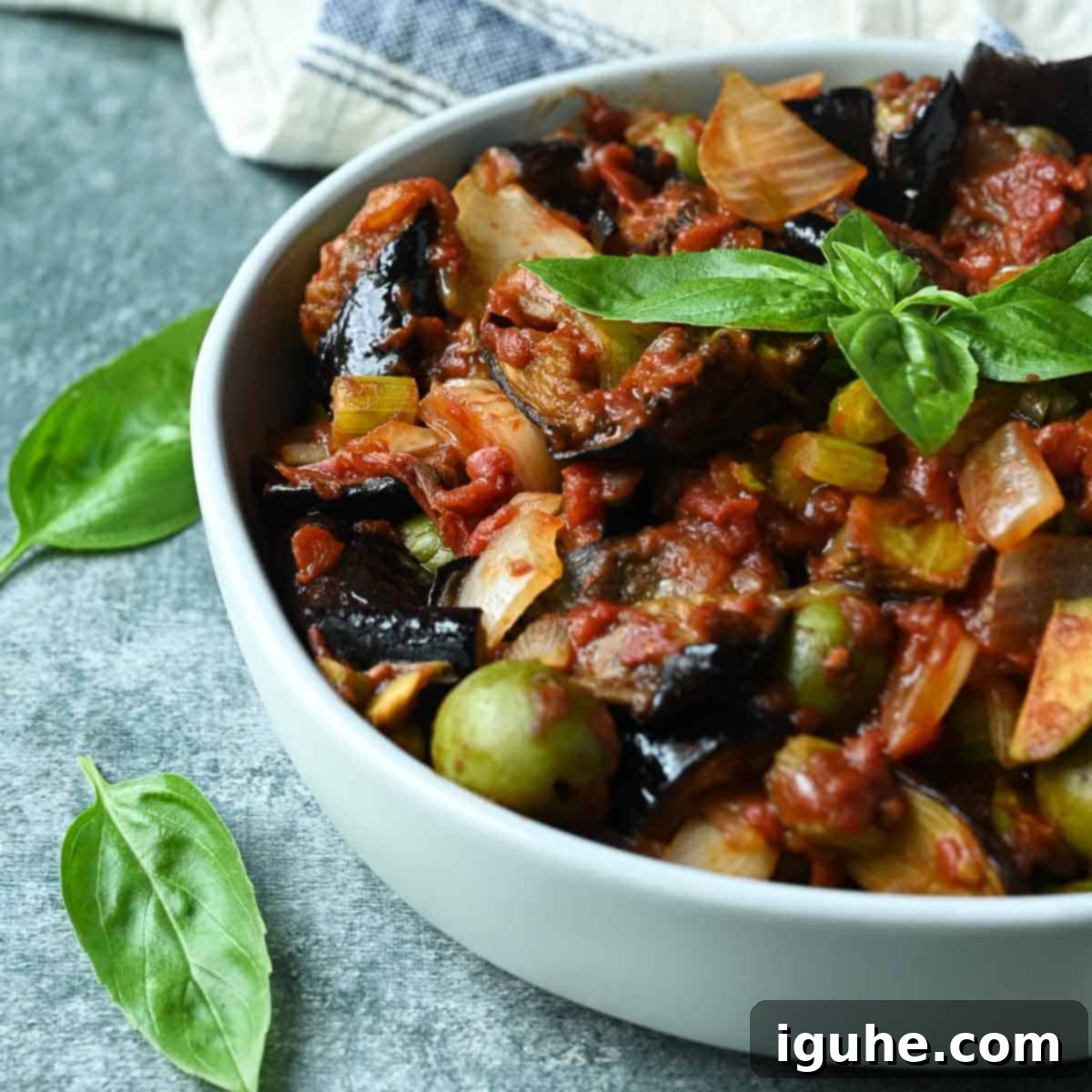Authentic Sicilian Eggplant Caponata: A Sweet, Tangy Mediterranean Masterpiece
Sicilian eggplant caponata is a celebrated sweet and tangy spread, a true emblem of Mediterranean flavors. This vibrant dish harmonizes tender eggplant, briny olives, pungent capers, aromatic onions, ripe tomatoes, and crisp celery into an irresistible medley. Traditionally served as a captivating appetizer, its rich and satisfying profile also makes it a delightful light main course or a versatile side dish.
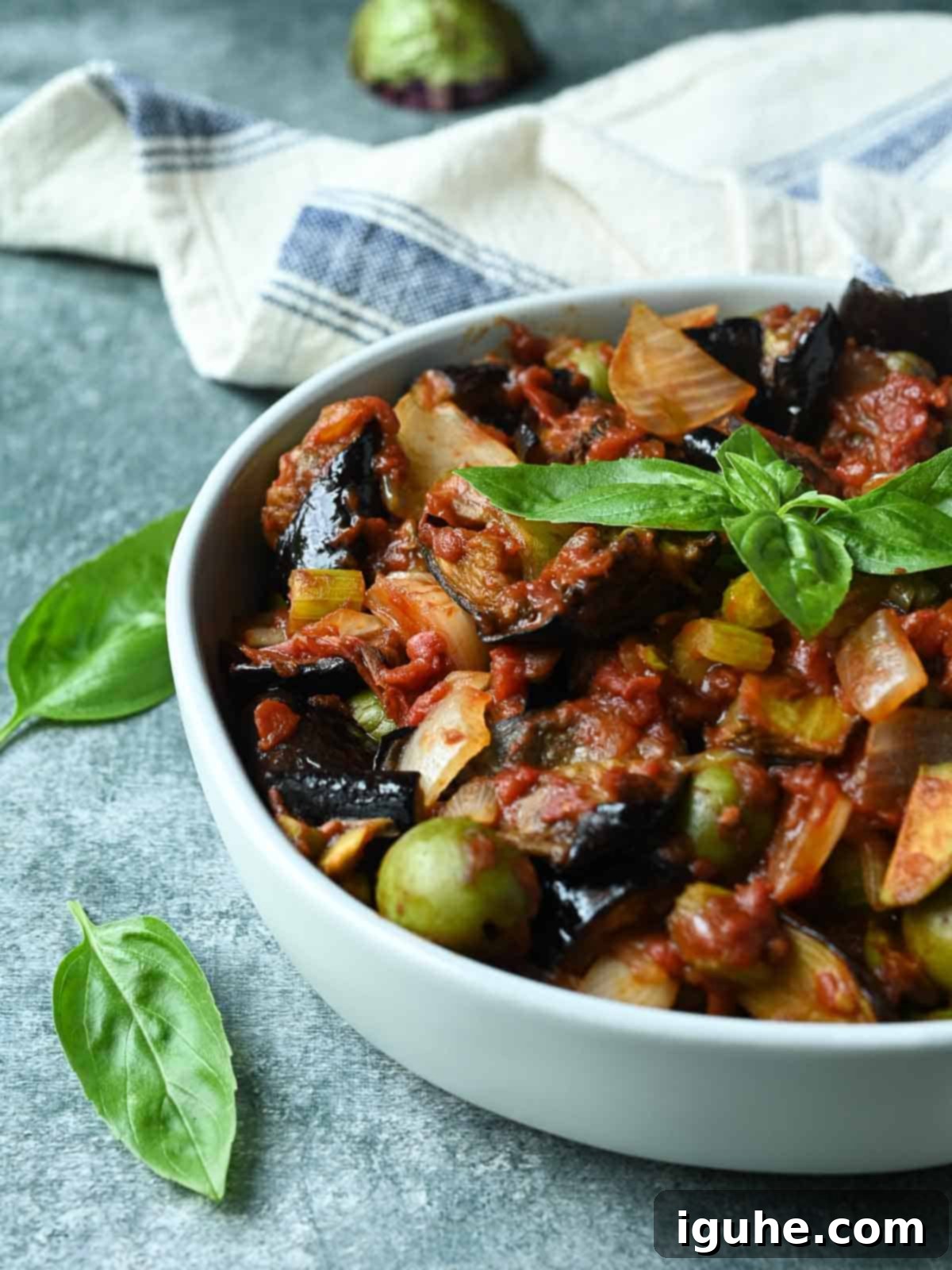
Caponata is more than just a dish; it’s a celebration of summer’s bounty. The wait for August each year is almost a ritual, as this is when eggplant, the star of this traditional Sicilian delicacy, reaches its peak freshness and flavor. This seasonality is key to achieving the authentic taste that makes caponata so beloved.
The beauty of Sicilian eggplant caponata lies in its rich history and regional variations. Recipes for this beloved dish can vary significantly from one Sicilian family to another, each boasting its own secret touch. While some versions might incorporate sweet red peppers, plump raisins, or even toasted pine nuts for added texture and complexity, my preferred approach emphasizes a delightful simplicity. I focus on the essential flavors of sweet onions, salty capers, crisp celery, and the distinctive briny notes of authentic Italian olives, allowing the quality of each ingredient to truly shine.
While traditional caponata often involves frying the eggplant, which results in a wonderfully rich texture, I frequently opt for roasting. This method saves both precious time and a considerable amount of olive oil, making it a lighter and more convenient option without sacrificing flavor. The eggplant emerges beautifully tender and slightly caramelized, perfect for absorbing the robust flavors of the sauce. Additionally, I elevate the dish by using my homemade tomato sauce. This sauce, often prepared with sun-ripened tomatoes, inherently possesses a subtle sweetness and depth, layering an extra dimension of authentic Italian taste into the caponata that canned tomatoes simply cannot replicate.
To achieve the signature sweet and tangy “agrodolce” balance that defines caponata, I rely on a high-quality balsamic vinegar. Its natural sweetness and complex acidity provide a more nuanced flavor than granulated sugar alone. However, if your tomatoes or tomato sauce lean towards the less sweet side, don’t hesitate to add a touch of sugar to adjust the balance to your personal preference. Tasting as you go is key to perfecting this iconic Sicilian relish.
Caponata is not merely a dish; it’s a testament to Sicilian culinary heritage, blending influences from various cultures throughout its history. The “agrodolce” profile, a harmonious blend of sweet and sour, is a hallmark of Sicilian cuisine, tracing its roots back to Arab influences on the island. This balance is what makes caponata so uniquely satisfying and endlessly appealing, whether served warm, at room temperature, or chilled.
[feast_advanced_jump_to]
Ingredient Notes: Crafting the Perfect Caponata
Creating this exquisite Italian caponata requires a selection of fresh, simple ingredients. Here’s a deeper dive into each component and how to choose the best ones for your dish:
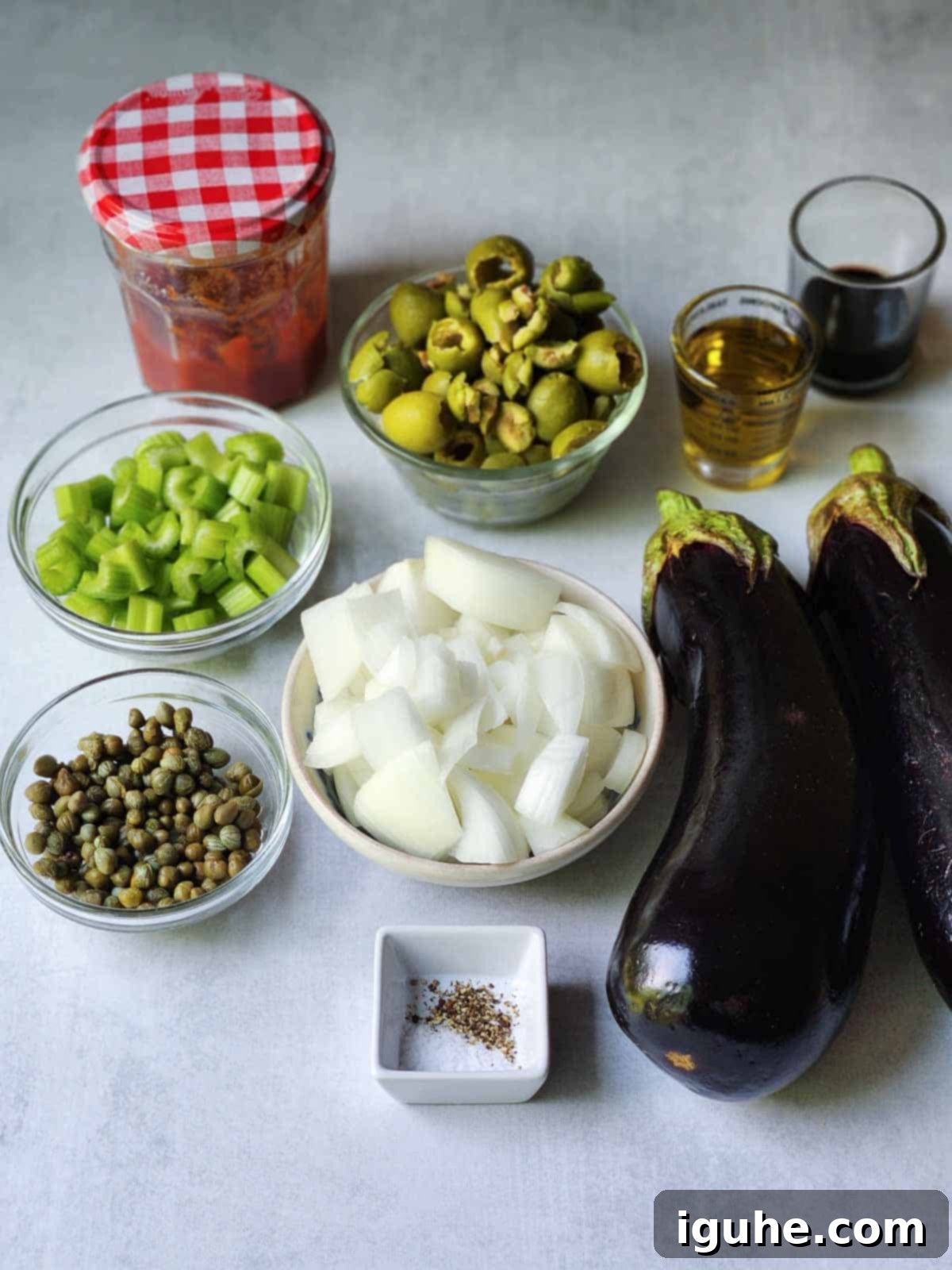
- Eggplant: The foundation of caponata. While many varieties exist, “Globe” (the large, shiny black ones commonly found in supermarkets), Italian, Graffiti (often called Sicilian eggplant), Japanese, and Chinese eggplants are excellent choices. I personally favor smaller Italian eggplants for their inherently more tender flesh and thinner skin. Many recipes traditionally recommend salting eggplant before frying to reduce bitterness and draw out moisture. However, for roasting, I find this step often unnecessary and tedious, especially with fresh, high-quality eggplant. Skipping it saves time without compromising flavor.
- Onion: Essential for building the aromatic base. Yellow, red, or Spanish onions will all work beautifully, adding a foundational sweetness when softened.
- Celery: Provides a refreshing crunch and a subtle, peppery brightness that contrasts wonderfully with the richness of the other ingredients, contributing to the dish’s overall acidity and freshness.
- Capers: These briny flower buds are a crucial component, offering a distinct salty and tangy burst of flavor. Always drain and rinse them thoroughly to prevent the caponata from becoming overly salty.
- Olives: A non-negotiable ingredient, olives lend a deep, savory, and slightly fruity note. My top recommendation is green Castelvetrano olives, known for their buttery texture and mild, sweet flavor. Other excellent Italian options include Cerignola (large, mild) and Picholine (fruity, nutty). Don’t be afraid to experiment with what you have; I’ve even made delicious caponata with Spanish manzanilla olives (after carefully removing their pimentos). Pro tip: Purchasing pitted olives will significantly streamline your preparation time.
- Tomato Sauce: The heart of the savory liquid base. While a high-quality canned crushed or diced tomato can work, using your favorite homemade tomato sauce will truly elevate the caponata, providing a richer, more complex flavor profile.
- Olive Oil: A staple in Mediterranean cooking, extra-virgin olive oil is used generously here for both roasting the eggplant to perfection and sautéing the vibrant array of vegetables, infusing the dish with its characteristic fruity and robust notes.
- Balsamic Vinegar: This is where the “agrodolce” magic happens! Balsamic vinegar introduces a complex tang and a subtle, natural sweetness. I prefer a balsamic with a slightly thicker consistency (not a glaze) and inherent sweetness, which contributes a more refined flavor. Red wine vinegar can also be used as a suitable alternative if balsamic is unavailable.
- Salt and Pepper: Basic seasonings are vital for enhancing and balancing all the flavors. Use Kosher salt or fine sea salt for best results, and fresh ground pepper for a pungent kick.
- Sugar: Optional, but useful for fine-tuning the sweetness. If your tomatoes or sauce aren’t naturally sweet, or if you prefer a more pronounced “sweet” in your “sweet and tangy,” add sugar to taste. It’s best to taste the caponata towards the end of cooking and adjust accordingly.
How to Make Sicilian Eggplant Caponata: Step-by-Step Guide
Achieving perfectly soft and tender eggplant is crucial for caponata. Roasting is my preferred method for its ease and reduced oil consumption compared to traditional frying, which requires more attention over the stove.
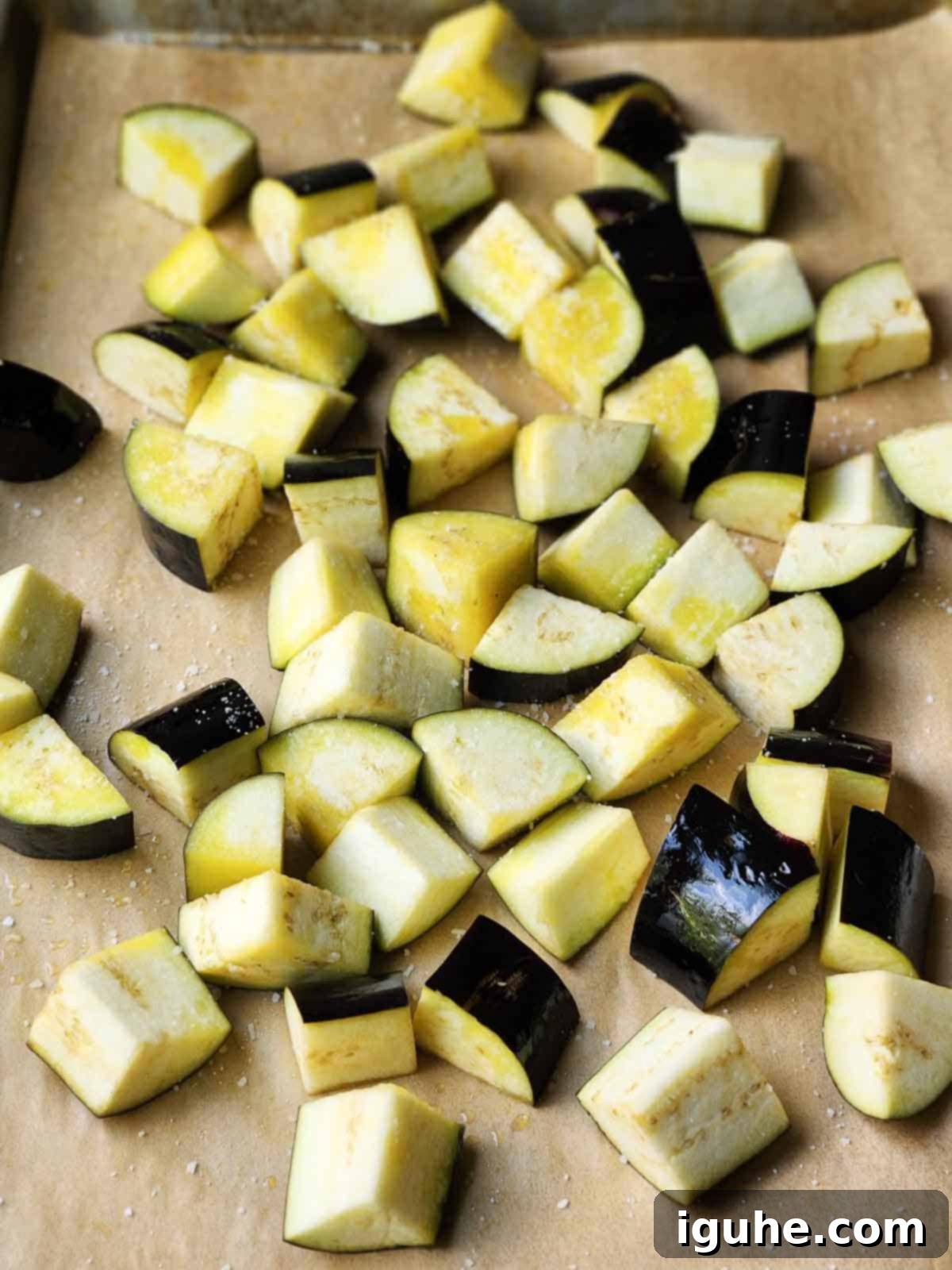
Begin by preheating your oven to the specified temperature. Line a large roasting pan or baking sheet with aluminum foil or parchment paper for easy cleanup. Cut your eggplant into uniform, bite-sized cubes, then transfer them to the prepared pan. Drizzle generously with olive oil and sprinkle with a pinch of salt. Toss everything together thoroughly, ensuring each eggplant piece is well coated before spreading them out in a single, even layer.
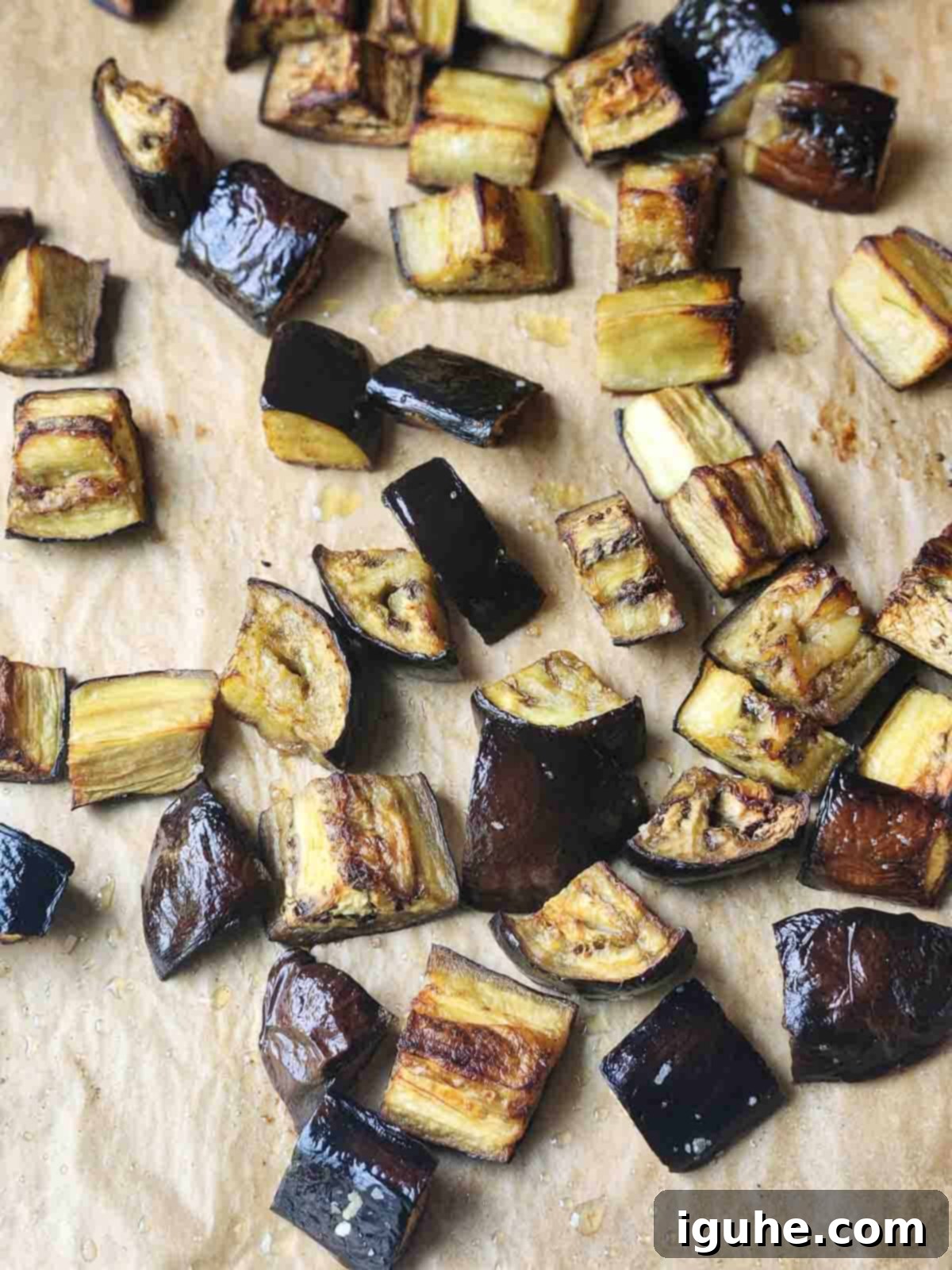
Roast the eggplant in the preheated oven until it becomes beautifully browned and undeniably fork-tender. This process typically takes about 35-45 minutes, with one flip halfway through to ensure even cooking and color development. Once done, remove the roasted eggplant from the oven and set it aside to cool slightly while you prepare the remaining aromatic components of the caponata.
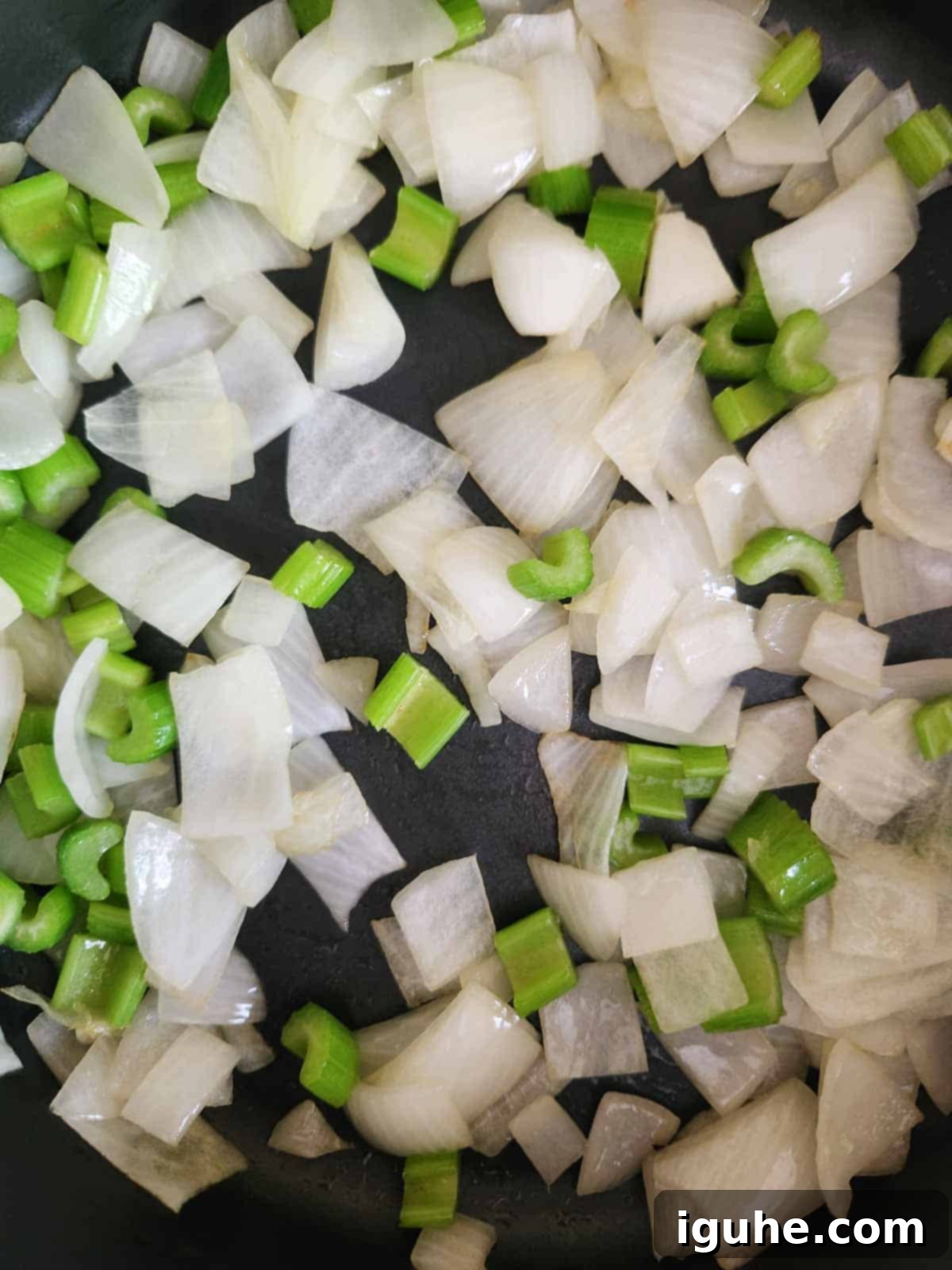
In a large skillet, heat the remaining olive oil over medium heat. Add the chopped onions and celery along with a small pinch of salt. Sauté these vegetables gently, stirring occasionally, until they become tender and translucent – you want them softened, not browned, to maintain their delicate flavor and texture within the caponata. This step usually takes about 3-5 minutes.
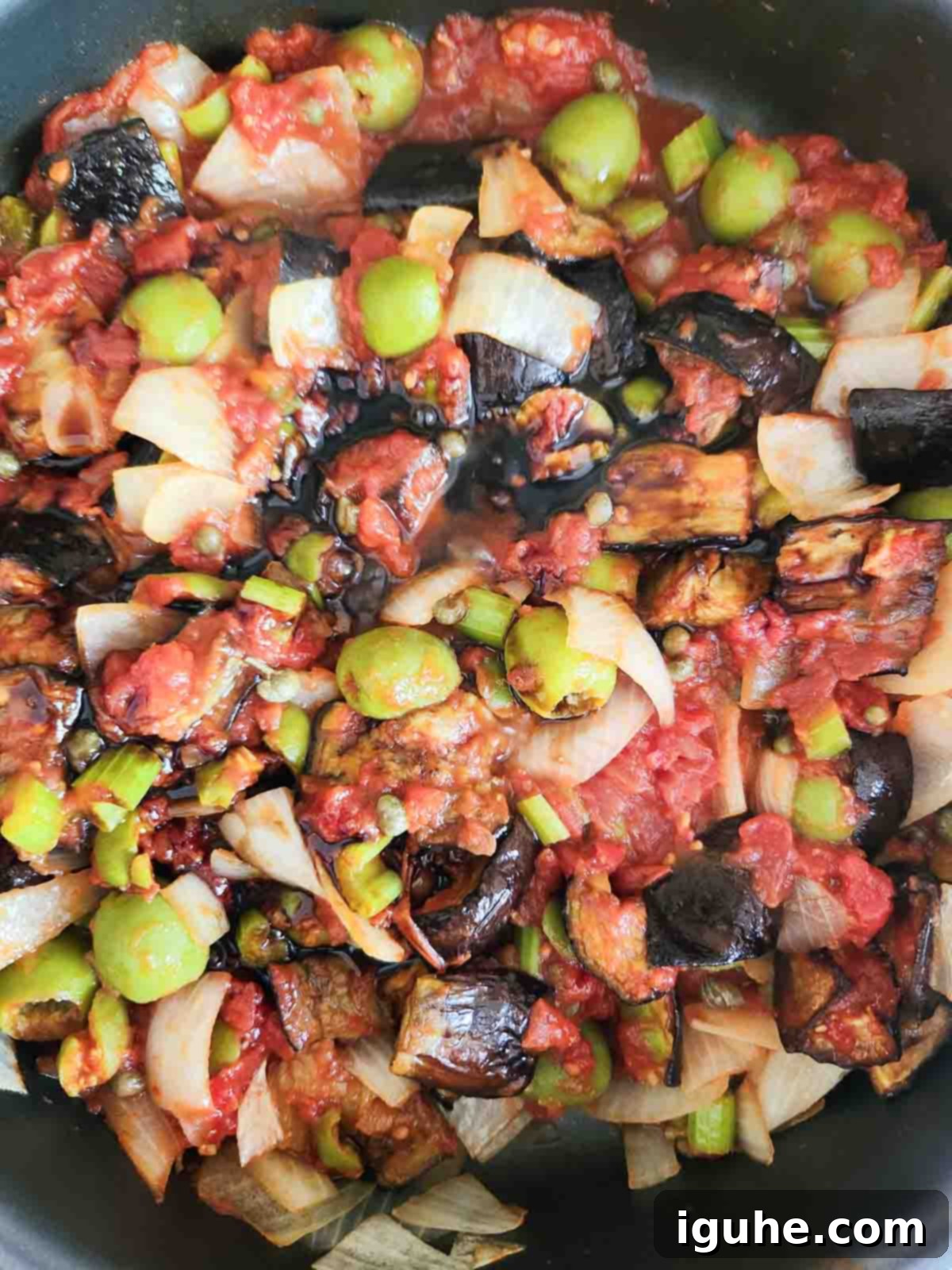
Now, it’s time to bring all the flavors together. Add the previously roasted eggplant, the sliced olives, rinsed capers, and your rich tomato sauce to the skillet with the softened onions and celery. Stir well to combine all the ingredients. Cover the skillet and bring the mixture to a gentle simmer. Allow it to cook for a few minutes, letting the flavors meld and deepen. Then, remove the cover and stir in the balsamic vinegar and the optional sugar. Continue to cook for another 1-2 minutes, stirring gently, until the caponata reaches a desirable, somewhat thick consistency. This final simmering allows the “agrodolce” balance to fully develop.
Once your caponata has achieved its perfect consistency, remove it from the heat. Taste it carefully and adjust the seasoning with additional salt and pepper as needed. For an extra touch of freshness and vibrant color, garnish with your choice of fresh herbs, such as basil or parsley, just before serving. Enjoy this versatile Sicilian delight warm, at room temperature, or chilled!
💡Expert Tip
If using smaller eggplant varieties like Italian eggplant, their tender skin means there’s no need to peel. For larger globe eggplants, which can have tougher skin, I recommend peeling it “zebra-style”—removing long strips while leaving some of the skin intact. This strikes a balance, ensuring a more palatable texture while still retaining some of the beneficial nutrients and vibrant color from the skin.
Substitutions and Variations: Customizing Your Caponata
While this caponata recipe is a favorite as written, the beauty of traditional Sicilian cooking lies in its adaptability. Every region, indeed every family, often has its own unique twist on caponata. Feel empowered to experiment with these delicious variations to find your personal perfect recipe:
- Peppers: For a touch of sweetness and color, many regional caponata recipes include chopped red bell peppers. Sauté them with the onions and celery to soften before adding other ingredients. They add a lovely vibrant hue and a mild, sweet counterpoint.
- Zucchini: If you’re looking to incorporate more vegetables or enhance the caponata’s freshness, consider adding roasted zucchini or yellow squash. Cut them into similar-sized cubes as the eggplant and roast them alongside. The squash will readily absorb the rich, tangy flavors of the caponata, adding another layer of texture and nutrition.
- Garlic: For those who appreciate an aromatic kick, a minced garlic clove can be a fantastic addition. Sauté it with the onions and celery for about a minute until fragrant, being careful not to burn it.
- Nuts: Some caponata variations feature a delightful crunch from nuts. Toasted pine nuts or thinly sliced almonds can be stirred in at the end, adding a subtle nutty flavor and an appealing textural contrast.
- Add Heat: If you enjoy a touch of spice, a pinch of crushed red pepper flakes or cayenne pepper can be incorporated during the sautéing process. This adds a subtle warmth that complements the sweet and tangy notes beautifully.
- Herbs: While fresh basil and parsley are common garnishes, try stirring in fresh mint or oregano for a different aromatic profile.
Serving Suggestions: Unleash Your Creativity with Caponata
Caponata’s remarkable versatility is one of its greatest assets. It’s equally delicious served hot, cold, or at room temperature, making it perfect for almost any occasion, from an elegant dinner party to a casual outdoor picnic. Get creative with these serving ideas:
- Appetizer: The classic choice! Serve your caponata with crusty, toasted bread, bruschetta, or artisanal crackers as a flavorful spread or relish. It’s an absolute must-have for an impressive charcuterie or antipasto board, adding a burst of Mediterranean flair.
- Side Dish: Caponata makes an exceptional side dish for a wide array of main courses. Its vibrant flavors pair wonderfully with grilled meats, roasted poultry, or delicate fish.
- Topping: Elevate simple proteins by using caponata as a gourmet topping. Spoon it over pan-seared chicken breasts, grilled salmon, or a perfectly cooked steak for an instant flavor boost.
- Pasta: This is my personal favorite! Toss warm caponata with your preferred pasta shape for an authentic, hearty Sicilian pasta dish. A sprinkle of fresh Parmesan or Pecorino Romano takes it to the next level.
- Breakfast/Brunch: Transform your breakfast into something special by incorporating caponata into a savory dish. Use it as a base for baked eggs, creating a Mediterranean-inspired “shakshuka” that’s bursting with flavor.
- Sandwiches & Savory Bites: Add a sweet and tangy twist to your everyday meals. Caponata makes an incredible relish for topping sandwiches, hot dogs, or grilled sausages, infusing them with a complex, savory depth.
- Grain Bowls: Combine caponata with cooked quinoa, farro, or couscous for a flavorful and nutritious vegetarian meal.
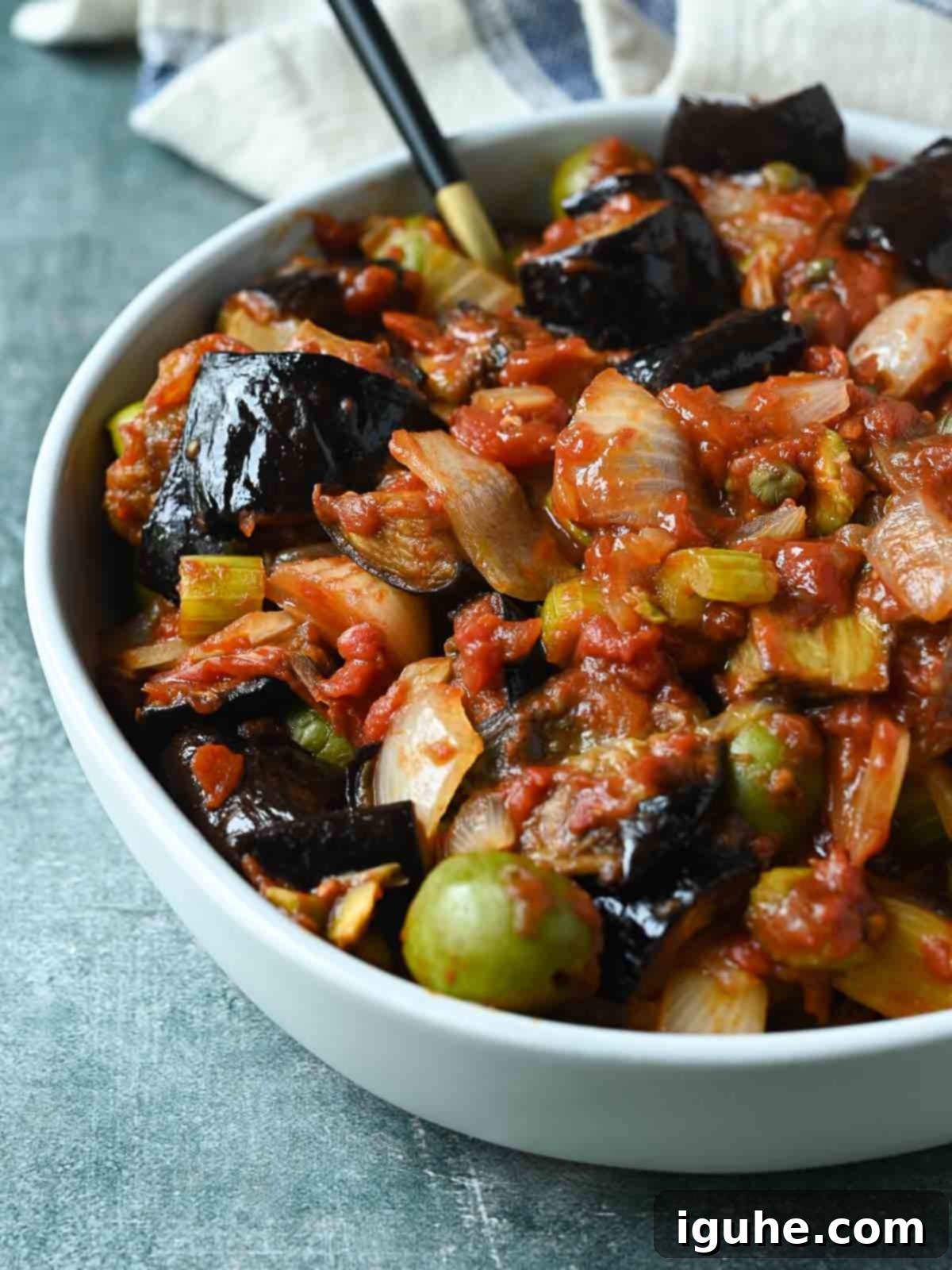
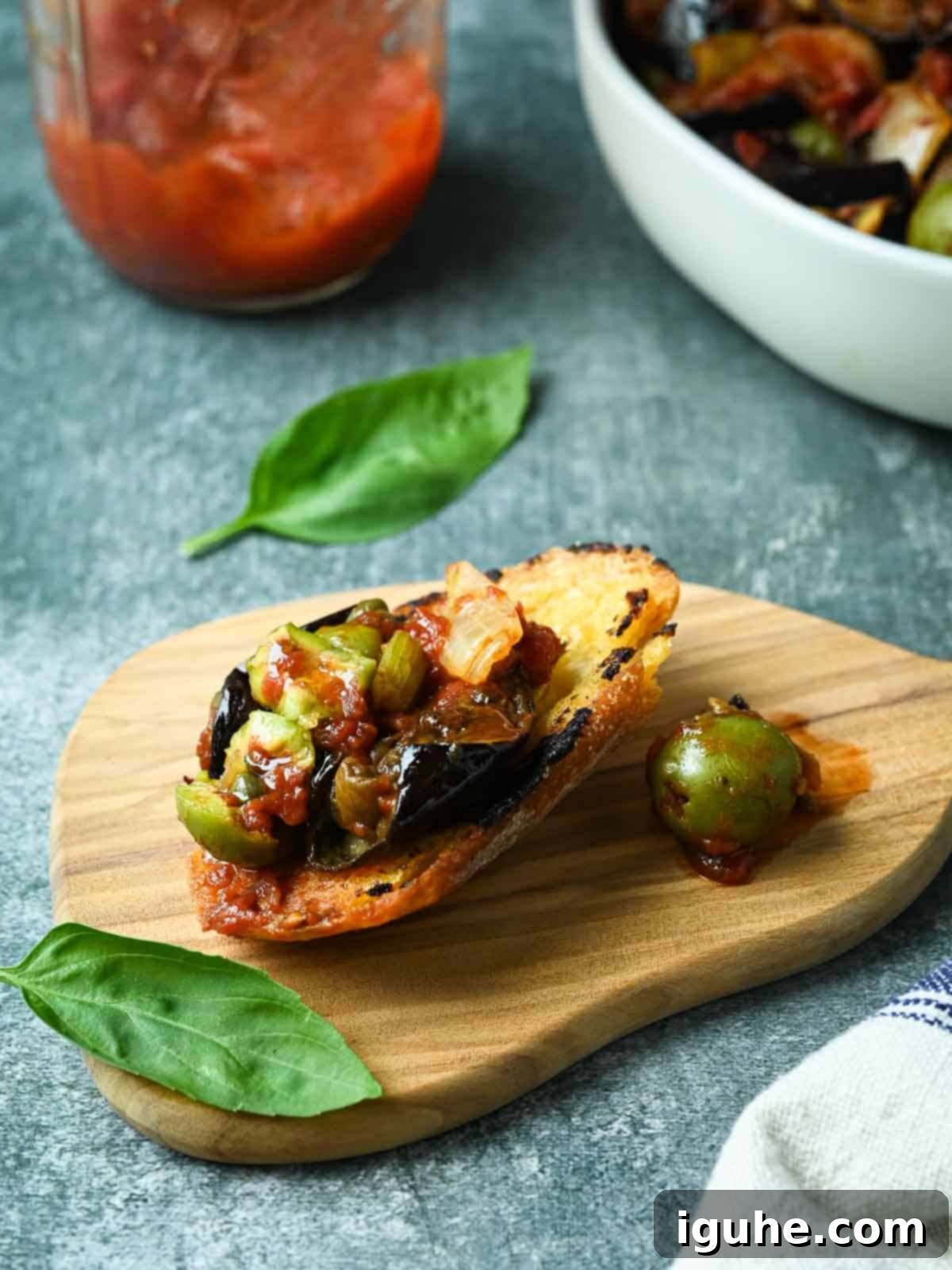
Storage
To preserve its exquisite flavor, caponata should be stored in an airtight container and refrigerated for up to 5 days. Interestingly, many find that caponata tastes even better the day after it’s made, as the flavors have more time to meld and deepen. This makes it an ideal dish for preparing ahead of time. Caponata also freezes exceptionally well for up to 3 months; just ensure it has cooled completely before transferring it to freezer-safe containers.
Frequently Asked Questions
Caponata is wonderfully versatile and can be enjoyed hot, cold, or at room temperature! Its ability to be served at various temperatures is part of what makes it so popular and perfect for outdoor gatherings, potlucks, and picnics. Many people actually prefer caponata after it has chilled for a few hours or even overnight, as the flavors have more time to fully develop and integrate, enhancing its characteristic sweet and tangy profile.
Caponata is a traditional Sicilian vegetable dish, often described as a relish or salad, characterized by its distinctive “agrodolce” (sweet and sour) flavor profile. It primarily features diced, fried or roasted eggplant and other vegetables like celery, olives, and capers, all simmered in a rich tomato sauce with vinegar and sometimes sugar. It’s a truly iconic dish that perfectly encapsulates the diverse culinary history of Sicily.
More Italian Recipes to Savor
Craving more authentic Italian flavors? Explore these delicious recipes that are sure to delight your palate!
- Easy Lemon Pizzelle
- Burrata Caprese Salad with Peaches
- Heirloom Tomato Sandwich with Pesto Aioli
- Italian Lemon Drop Cookies
Did you make this recipe? I would love to hear about it! Please leave a ⭐⭐⭐⭐⭐ rating with a comment right below the recipe card. If you snap a photo of your creation, don’t forget to tag me on Instagram @brunchandbatter.
📖Recipe
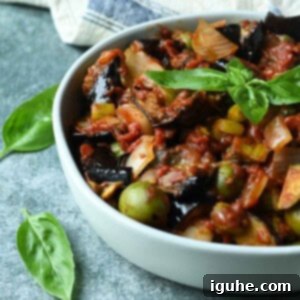
Sicilian Eggplant Caponata
Pin Recipe
Equipment
-
baking sheet or roasting pan
-
large non-stick skillet
Ingredients
- 1 lb (5 cups chopped) eggplant (2 medium or 1 large eggplant), cut into ½ inch chunks
- 3 tablespoon extra-virgin olive oil, divided
- ½ teaspoon Kosher salt or fine sea salt, divided, plus more to taste
- 1 small onion, chopped (about 1 cup chopped)
- 2-3 stalks celery, chopped (about ½ cup chopped)
- 1⅓ cups pitted green olives such as Castelvetrano, sliced in half
- ¼ cup capers, rinsed and drained
- 2 cups tomato sauce
- 4-6 tablespoon balsamic or red wine vinegar
- 1 tablespoon white granulated sugar (optional)
- fresh ground pepper, to taste
- fresh herbs such as basil or parsely, optional
Instructions
-
Preheat the oven to 425℉. Add the eggplant, 2 tablespoon olive oil, and ¼ teaspoon salt to a large baking sheet (or roasting pan). Toss to coat well. Spread the eggplant in an even layer. Roast the eggplant until browned and fork tender (turning once halfway through cooking), anout 35-45 minutes. Set aside.1 lb (5 cups chopped) eggplant (2 medium or 1 large eggplant), cut into ½ inch chunks, 3 tablespoon extra-virgin olive oil, divided, ½ teaspoon Kosher salt or fine sea salt, divided, plus more to taste
-
Heat a large skillet over medium heat. Add the remaining tablespoon of olive oil. Saute the onions, celery, and remaining ¼ teaspoon of salt until softened, about 3-5 minutes. Add the roasted eggplant, capers, olives, and tomato sauce. Cover and bring to a simmer. Reduce the heat to medium-low, and simmer for 5-8 minutes. Remove the cover, and add the vinegar and sugar (if using). Cook for another 1-2 minutes. The caponata should be somewhat thick. Add additional salt and pepper to taste. Stir in the fresh herbs (if using). Serve warm or at room temperature.1 small onion, chopped (about 1 cup chopped), 2-3 stalks celery, chopped (about ½ cup chopped), 1⅓ cups pitted green olives such as Castelvetrano, sliced in half, ¼ cup capers, rinsed and drained, 2 cups tomato sauce, 4-6 tablespoon balsamic or red wine vinegar, 1 tablespoon white granulated sugar (optional), fresh ground pepper, to taste, fresh herbs such as basil or parsely, optional
Notes
- Caponata can be stored in the fridge for up to 5 days.
- Caponata tastes better the next day after the flavors have had a chance to meld, making it perfect for making ahead.
Nutrition*
*Nutrition information is provided as a courtesy and is an estimate only. Nutrition information can vary depending on many factors, such as products used, measurements and substitutions, therefore it is recommended that you obtain nutritional calculations based on your own finished recipe.
